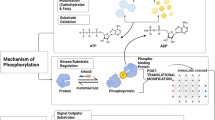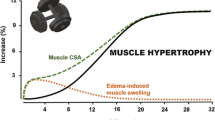Summary
The response of muscle fiber type proportions and fiber areas to 15 weeks of strenuous high-intensity intermittent training was investigated in twenty-four carefully ascertained sedentary (14 women and 10 men) and 10 control (4 women and 6 men) subjects. The supervised training program consisted mainly of series of supramaximal exercise lasting 15 s to 90 s on a cycle ergometer. Proportions of muscle fiber type and areas of the fibers were determined from a biopsy of the vastus lateralis before and after the training program. No significant change was observed for any of the histochemical charactertics in the control group. Training significantly increased the proportion of type I and decreased type IIb fibers, the proportion of type IIa remained unchanged. Areas of type I and IIb fibers increased significantly with training. These results suggest that high-intensity intermittent training in humans may alter the proportion of type I and the area of type I and IIb fibers and in consequence that fiber type composition in human vastus lateralis muscle is not determined solely by genetic factors.
Similar content being viewed by others
References
Blomstrand E, Ekblom B (1982) The needle biopsy technique for fiber type determination in human skeletal muscle — a methodological study. Acta Physiol Scand 116:437–442
Bonen A, Campbell CJ, Kirby RL, Belcastro AN (1978) Relationship between slow-twitch muscle fibers and lactic acid removal. Can J Appl Sport Sci 3:160–162
Boulay MR, Lortie G, Simoneau JA, Bouchard C (1985) Sensitivity of maximal aerobic power and capacity to anaerobic training is partly genotype dependent. In: Malina RM, C Bouchard (eds). Sport and human genetics. Human Kinetics, Champaign (IL) [in press]
Constable SH, Collins RL, Krahenbuhl GS (1980) The specificity of endurance training on muscular power and muscle fibre size. Ergonomics 23:667–678
Costill DL, Fink WF, Pollock ML (1976) Muscle fiber composition and enzyme activities of elite distance runners. Med Sci Sports 8:96–100
Costill DL, Coyle EF, Fink WF, Lesmes GR, Witzmann FA (1979) Adaptations in skeletal muscle following strength training. J Appl Physiol: Respirat Environ Exercise Physiol 46:96–99
Evans WJ, Phinney SD, Young VR (1982) Suction applied to a muscle biopsy maximized sample size. Med Sci Sports Exerc 14:101–102
Gollnick PD, Armstrong RB, Saubert W, Piehl K, Saltin B (1972) Enzyme activity and fiber composition in skeletal muscle of untrained and trained men. J Appl Physiol 33:312–319
Gollnick PD, Armstrong RB, Saltin B, Saubert CW, Sembrowich WL, Sheperd RE (1973) Effect of training on enzyme activity and fiber composition of human skeletal muscle. J Appl Physiol 34:107–111
Green HJ (1979) Metabolic aspects of intermittent work with specific regard to ice hockey. Can J Appl Sport Sci 4:29–34
Green HJ, Klug GA, Reichmann H, Seedorf U, Wiehrer W, Pette D (1984) Exercise-induced fibre type transition with regard to myosin, parvalbumin, and sarcoplasmic reticulum in muscles of the rat. Pflügers Arch 400:432–438
Halkjaer-Kristensen J, Ingemann-Hansen T (1981) Variations in single fiber areas and fiber composition in needle biopsies from the human quadriceps muscle. Scand J Clin Lab Invest 41:391–395
Hermansen L (1979) Effect of acidosis on skeletal muscle performance during maximal exercise in man. Bull Eur Physiopathol Resp 15:229–238
Holloszy JO, Coyle EF (1984) Adaptations of skeletal muscle endurance exercise and their metabolic consequences. J Appl Physiol: Respirat Environ Exercise Physiol 56:831–838
Komi PV, Karlsson J (1979) Physical performance, skeletal muscle enzyme activities and fiber types in monozygous and dizygous twins of both sexes. Acta Physiol Scand [Suppl] 462:1–28
Lortie G, Simoneau JA, Boulay MR, Bouchard C (1985) Muscle fiber type composition and enzyme activities in brothers and monozygotic twins. In: Malina RM, Bouchard C (eds): Sport and human genetics. Human Kinetics, Champaign (IL) [in press]
Luginbuhl AJ, Dudley GA, Staron RS (1984) Fiber type changes in rat skeletal muscle after intense interval training. Histochemistry 81:55–58
Mabuchi K, Sréter FA (1980) Actomyosin ATPase. II. Fiber typing by histochemical ATPase reaction. Muscle and Nerve 3:233–239
MacNab R, Conger PR, Taylor PS (1969) Differences in maximal and submaximal work capacity in men and women. J Appl Physiol 27:644–648
Mahon M, Toman A, Willan PLT, Bagnall KM (1984) Variability of histochemical and morphometric data from needle biopsy specimens of human quadriceps femoris muscle. J Neurol Sci 63:85–100
Orlander J, Kiessling KH, Karlsson J, Ekblom B (1977) Low intensity training, inactivity and resumed training in sedentary men. Acta Physiol Scand 101:351–362
Pette D (1984) Activity-induced fast to slow transitions in mammalian muscle. Med Sci Sports Exerc 16:517–528
Prud'Homme D, Bouchard C, Leblanc C, Landry F, Lortie G, Boulay MR (1984) Reliability of assessments of ventilatory thresholds. J Sports Sci 2:13–24
Reichmann H, Pette D (1982) A comparative microphotometric study of succinate dehydrogenase activity levels in type I, IIa and IIb fibers of mammalian and human muscles. Histochemistry 74:27–41
Sahlin K, Harris RC, Hultman E (1979) Resynthesis of creatine phosphate in human muscle after exercise in relation to intramuscular pH and availability of oxygen. Scand J Clin Lab Invet 39:551–558
Saltin B, Nazar K, Costill DL, Stein E, Jansson E, Essen B, Gollnick PD (1976) The nature of the training response; peripheral and central adaptations to one-legged exercise. Acta Physiol Scand 96:289–305
Simoneau JA, Lortie G, Boulay MR, Thibault MC, Thériault G, Bouchard C (1985) Skeletal muscle histochemical and biochemical characteristics in sedentary male and female subjects. Can J Physiol Pharmacol 63:30–35
Sjogaard G (1978) Force-velocity curve for bicycle work. In: Asmussen E, Jorgensen K (eds) Biomechanics VIa. University Park Press, Baltimore, p 93
Thorstensson A (1976) Muscle strength, fiber types and enzyme activities in man. Acta Physiol Scand [Suppl] 443:1–45
Author information
Authors and Affiliations
Rights and permissions
About this article
Cite this article
Simoneau, J.A., Lortie, G., Boulay, M.R. et al. Human skeletal muscle fiber type alteration with high-intensity intermittent training. Europ. J. Appl. Physiol. 54, 250–253 (1985). https://doi.org/10.1007/BF00426141
Accepted:
Issue Date:
DOI: https://doi.org/10.1007/BF00426141




